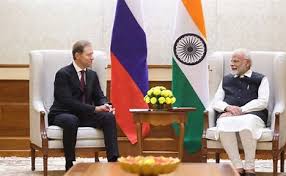The 27th sojourn by Prime Minister Narendra Modi outside the country to United Arab Emirates August on 16-17 is significant and remarkable not only because he is the first prime minister to go to this country after Indira Gandhi’s visit 34 years ago. Nor also because he is visiting a country which contributes about 15% of the total inward remittances (USD 15.7 billion out of a total of USD 69 billion received by India from all over the world in 2014-15). Nor even for the fact that Indians constitute about 30% of the total population (2.6 million out of a total population that is a shade above 9 million, less than half the population of Delhi). The visit is exceptional because this will be the first visit by Prime Minister Modi to West Asia, to a Muslim country and to a Gulf Arab country. This is one region that Mr Modi has not visited so far, although he has straddled across hemispheres over the last 14 months of his tenure.
PM Modi’s choice of UAE to be the first country of his visit in the energy-rich but troubled region is as compelling and momentous as was his choice of Bhutan to be the country for his first bilateral visit after assuming power. PM Modi is giving the same importance to UAE as he gave to India’s neighbours like Bhutan, Nepal and Bangladesh by making this a single country tour and not combining it with other countries. This also sends out a clear message that UAE occupies the same importance and relevance in India’s foreign policy matrix as its immediate neighbours.
What’s on agenda?
 The visit has major strategic and economic dimensions. PM Modi’s visit also comes months before the first visit ever by an Indian president to Israel in October. In addition to Israel, Pranab Mukherjee will also travel to Palestine and Jordan.
The visit has major strategic and economic dimensions. PM Modi’s visit also comes months before the first visit ever by an Indian president to Israel in October. In addition to Israel, Pranab Mukherjee will also travel to Palestine and Jordan.
Inward investments, security and defence, and energy, along with enhanced trade and interaction with the Indian diaspora, will be the main issues that will engage attention of PM Modi during his stay in the Emirates.
Economic Diplomacy
With bilateral trade of USD 60 billion, UAE is the third largest trading partner for India, and India is the second largest trading partner of the UAE. This is a reflection of the very close and intimate relations that have existed over centuries between the two countries. Notwithstanding the fact that it is a close and intimate relationship, it needs to be nurtured and nourished through frequent contacts and interactions at the highest level, which PM Modi’s visit will seek to achieve.
PM Modi will also be looking at attracting investment from the sovereign fund of UAE, which is reportedly sitting over investible funds to the tune of USD 800 billion- 1 trillion. India would like some of this to be channelled into Indian projects relating to infrastructure, smart cities, railways, Digital India, Make in India and other similar initiatives launched by the Modi government.
Connecting to Diaspora
Meeting and interacting with the Indian diaspora has come to occupy a special place in all of PM Modi’s visits, right from the rock star reception he was accorded at Madison Square Garden in New York to the Allphones Arena in the Olympic Park in Sydney. The Indian-origin people will be keenly looking forward to welcoming him at the International Cricket Stadium in Dubai on August 17, with an overflowing house of more than 30,000 people. It will be the first time that an expatriate community of this size will be addressed by any foreign leader in a West Asian country. Besides those physically present in the cricket stadium, PM Modi will have eyes and ears of more than 7 million Indians in the six Gulf States which comprise more than 25% of the Indian diaspora spread across continents.
Most Indian-origin residents of UAE and other Gulf countries are unskilled and semi-skilled workers. Only about 20% of the Indian diaspora in the region comprises professionals who are engaged in IT, banking, business or other managerial and executive positions. Their problems are different, the backgrounds from which they come are different and their aspirations are much removed from those of the well-heeled Indians he has so far encountered in other capital cities he has visited across the world. They are diverse and pluralistic, multi lingual and multi-religious. Most of them are blue collar workers. However, their contribution in terms of remittances which provide an impetus to the domestic economies of states like Kerala, Tamil Nadu and Karnataka that most of them hail from, cannot be underestimated. The contribution of the 7 million-strong Indian community in the Gulf in helping the government deal effectively with the burgeoning current account deficit is no less, if not more, than that of the Indian diaspora in western countries. These Indians will hence be keenly looking for those elements in the Prime Minister’s speech which will indicate as to how their living conditions will improve as a result of discussions between India and UAE.
Energy security
UAE is pivotal to India’s energy security as it is the sixth largest oil supplier to Asia’s third largest economy. With crude prices near an all-time low and there being no immediate possibility of their witnessing a rebound, it would provide a useful opportunity to finalise long-term deals for supply of oil for Indian refineries at attractive prices. This could prove to be a win-win outcome for both countries, one of which is surplus in energy and the other whose energy needs will continue to rise rapidly as its economy expands and grows.
Security Imperatives
Security and defence is another area which will engage the minds of leaders when PM Modi confers with Sheikh Mohamed bin Zayed Al Nahyan, Crown Prince of Abu Dhabi, and Sheikh Mohammed bin Rashid Al Maktoum, the Vice-President and Prime Minister of the UAE. UAE is concerned at the increasing violence in West Asia, with the rise of ISIS which has captured vast swathes of land and territory in Iraq and Syria and which is rapidly expanding its influence in Central Asia and Afghanistan. The drawdown of the US and NATO-ISAF forces in Afghanistan has led to a resurgence in the activities of Taliban, with an ever increasing number of attacks and deaths of Afghan security forces as well as well as innocent women and children. Violence and disturbances in Yemen, Egypt and Libya in this fragile and volatile region are a matter of anxiety for both India and UAE. Exchange of views between the leaders could help to identify common strategies and course of action including joint exercises and intelligence sharing to deal effectively with this increasing threat.
Looking ahead, the two-day day visit by Prime Minister Modi to UAE has the potential to radically transform and revitalise the bilateral relationship in all spheres of engagement including energy, trade, investment, security and defense, people to people and diaspora related issues.
 (Ashok Sajjanhar is a former ambassador of India and a commentator on foreign policy issues. This article has been written exclusively for India Writes Network)
(Ashok Sajjanhar is a former ambassador of India and a commentator on foreign policy issues. This article has been written exclusively for India Writes Network)
Author Profile
- India Writes Network (www.indiawrites.org) is an emerging think tank and a media-publishing company focused on international affairs & the India Story. Centre for Global India Insights is the research arm of India Writes Network. To subscribe to India and the World, write to editor@indiawrites.org. A venture of TGII Media Private Limited, a leading media, publishing and consultancy company, IWN has carved a niche for balanced and exhaustive reporting and analysis of international affairs. Eminent personalities, politicians, diplomats, authors, strategy gurus and news-makers have contributed to India Writes Network, as also “India and the World,” a magazine focused on global affairs.
Latest entries
 DiplomacyOctober 4, 2025UNGA Resolution 2758 Must Not Be Distorted, One-China Principle Brooks No Challenge
DiplomacyOctober 4, 2025UNGA Resolution 2758 Must Not Be Distorted, One-China Principle Brooks No Challenge India and the WorldJuly 26, 2025MPs, diplomats laud Operation Sindoor, call for national unity to combat Pakistan-sponsored terror
India and the WorldJuly 26, 2025MPs, diplomats laud Operation Sindoor, call for national unity to combat Pakistan-sponsored terror India and the WorldJuly 25, 2025When Fire Ends, Diplomacy Begins
India and the WorldJuly 25, 2025When Fire Ends, Diplomacy Begins India and the WorldJuly 16, 2025Operation Sindoor and its Aftermath: India’s Successful Diplomatic Outreach
India and the WorldJuly 16, 2025Operation Sindoor and its Aftermath: India’s Successful Diplomatic Outreach









